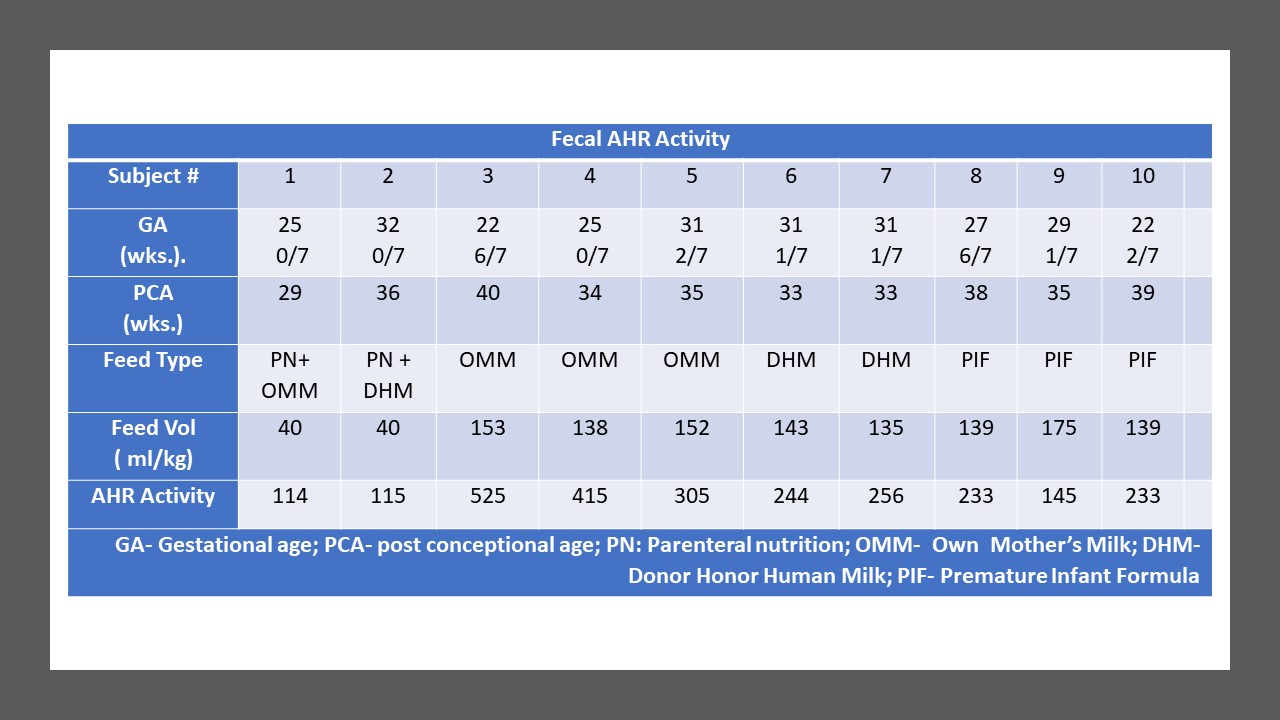Neonatal Fetal Nutrition & Metabolism
Category: Abstract Submission
Neonatal Fetal Nutrition & Metabolism I
274 - Effect of Own Mother's Milk and Donor Human Milk on Aryl Hydrocarbon Receptor Activity in Very Low Birth Weight Infants
Friday, April 22, 2022
6:15 PM - 8:45 PM US MT
Poster Number: 274
Publication Number: 274.119
Publication Number: 274.119
Prabhu S. Parimi, Metro Health Medical Center, Cleveland, OH, United States; Josie Libertucci, McMaster University Michael G. DeGroote School of Medicine, Hamilton, ON, Canada; Afeez Adisa, Case Western Reserve University School of Medicine, Cleveland, OH, United States

Afeez K. Adisa, MD. FWACP, MRCPCH
Fellow, Division of Neonatology
Metro Health Medical Center
Cleveland, Ohio, United States
Presenting Author(s)
Background: Aryl Hydrocarbon Receptor (AHR) is a cytoplasmic transcription factor expressed ubiquitously including in the intestinal epithelial and immune cells and a key modulator of immune homeostasis. AHR activity is regulated by Tryptophan (TRP) and AHR ligands (Indoles, Kynurenine, Kynurenic Acid and Serotonin) and Cyp1A1. Studies in inflammatory bowel disease and recent data in newborn animals with necrotizing enterocolitis (NEC) confirm the important role of AHR in gut inflammation. Compelling evidence in VLBW infants show that Own Mother's Milk (OMM) use leads to establishment of favorable gut microbiota, improvement in clinical outcomes including lowering the incidence of NEC. The effect of OMM and DHM on AHR activity in VLBW infants is not known. We hypothesize that exclusive OMM results in higher intestinal AHR activity compared to DHM.
Objective: To determine the effect of Own Mother's Milk and Donor Human milk on intestinal AHR activity in VLBW Infants
Design/Methods: Newborn infants ≤1500g and ≤ 32 weeks at birth (n=25) were recruited prospectively. Study infants received either OMM or DHM (Ni-Q HDM) at 10-15 ml/kg/d between 2-8 days after birth for 2-7 days, followed by 10-20 ml/kg/day increase until ~130 ml/kg/day, at which time parenteral nutrition was discontinued. Both OMM and DHM were fortified per protocol. Demographic, clinical and nutritional data were collected. To assess the effect of type of human milk on intestinal AHR activity, stool samples were collected during trophic feeds, and at half and full enteral feeds. AHR activity of fecal samples was measured using H1L1.1c2 cells containing a stably integrated DRE driven firefly luciferase reporter plasmid pGudLuc1.1. Negative controls consisted of cells treated with DMEM and tryptophan, while 2,3,7,8-tetrachlorodibenzo-p-dioxin diluted in DMEM was used as positive control and measurement of lactate dehydrogenase (LDH) activity for cytotoxicity. We report our pilot data on 10 VLBW infants.
Results: [Table]
In this pilot study, exclusive OMM feeds resulted in higher AHR activity compared to DHM and PIF. Infants on trophic feeds of OMM or DHM demonstrated lowest AHR activity.Conclusion(s): We propose that exclusive OMM feeding promotes catabolism of TRP to AHR ligands due to higher dose of TRP, human milk oligosaccharides and favorable gut microbiota, and binding to AHR in the intestinal epithelial and immune cells leading to higher AHR activity. Ongoing investigation by our group will lend important data on constituents in human milk (TRP, human milk oligosaccharides and milk microbiota) on AHR activity and their impact on immune homeostasis.
Fecal AHR Activity in VLBW Infants
Objective: To determine the effect of Own Mother's Milk and Donor Human milk on intestinal AHR activity in VLBW Infants
Design/Methods: Newborn infants ≤1500g and ≤ 32 weeks at birth (n=25) were recruited prospectively. Study infants received either OMM or DHM (Ni-Q HDM) at 10-15 ml/kg/d between 2-8 days after birth for 2-7 days, followed by 10-20 ml/kg/day increase until ~130 ml/kg/day, at which time parenteral nutrition was discontinued. Both OMM and DHM were fortified per protocol. Demographic, clinical and nutritional data were collected. To assess the effect of type of human milk on intestinal AHR activity, stool samples were collected during trophic feeds, and at half and full enteral feeds. AHR activity of fecal samples was measured using H1L1.1c2 cells containing a stably integrated DRE driven firefly luciferase reporter plasmid pGudLuc1.1. Negative controls consisted of cells treated with DMEM and tryptophan, while 2,3,7,8-tetrachlorodibenzo-p-dioxin diluted in DMEM was used as positive control and measurement of lactate dehydrogenase (LDH) activity for cytotoxicity. We report our pilot data on 10 VLBW infants.
Results: [Table]
In this pilot study, exclusive OMM feeds resulted in higher AHR activity compared to DHM and PIF. Infants on trophic feeds of OMM or DHM demonstrated lowest AHR activity.Conclusion(s): We propose that exclusive OMM feeding promotes catabolism of TRP to AHR ligands due to higher dose of TRP, human milk oligosaccharides and favorable gut microbiota, and binding to AHR in the intestinal epithelial and immune cells leading to higher AHR activity. Ongoing investigation by our group will lend important data on constituents in human milk (TRP, human milk oligosaccharides and milk microbiota) on AHR activity and their impact on immune homeostasis.
Fecal AHR Activity in VLBW Infants

